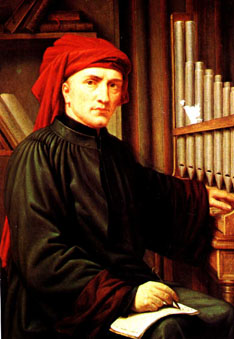Lindsay Lozito
351 WI
Dr. Granade
October 22, 2009
Josquin de Prez: Ave Maria…virgo serena

Widely admired, Josquin de Prez is one of the greatest Renaissance composers. He composed a significant amount of sacred and secular music and caught the eye of Ottaviano Petrucci, the first printer of polyphonic music. Petrucci eventually published three significant books of Josquin’s masses, just a taste of the composer's major works which included masses, chansons, and motets. His style of music was all about the clarity of text. Josquin’s works became popular during the Renaissance Era and were widely sung even after his death. One of those pieces is the Ave Maria…virgo serena, which is one example of how he emphasizes his expression of the poetic text.
Josquin’s over fifty motets carry on the traits of the late fifteenth century style, especially in the clarity of the text. His popular, four-voice Ave Maria…virgo serena (c. 1485) demonstrates Josquin’s interest in clear delineation of the text, as he wrote the piece so the music would fit the form of the words. The opening section begins with clear imitation of each phrase from the highest voice to the lowest voice. This imitation scheme continues throughout the movement, showing the variety and expressivity of the words as each musical subject that is imitated represents Angels hailing Mary. As the piece continues to the first poetic line, the imitation changes. Instead of each voice imitating the opening phrase, the imitation alternates between two voices. For example in measure twenty-seven, the soprano voice initiates the musical phrase, which is imitated by the alto voice. Three measures later, the tenor voice initiates the musical phrase and is then imitated by the bass voice. This alternation continues as the rhythmic activity increases during the drive to the cadence. At the beginning of the first poetic line, the imitation changes to four-voice homophony. Throughout the remainder of the line, Josquin staggers the rhythm between the four voices to represent “heavenly and earthly” voices. He continuously varies the texture for the rest of the piece including meter shifts from duple to triple meter at two separate points. This provides some contrast within the piece. At the end of the Ave Maria…virgo serena, Josquin creates an expressive moment by slowing the tempo down and changing the texture. The singers are in rhythmic unison with simple harmonies to portray the text “O Mother of God, remember me. Amen.”
It is interesting listening to the piece both before and after you have studied it thoroughly. The first time you listen to it, you are just beginning to touch on the meaning of the piece. You can hear certain characteristics that are particular to the piece such as more emphasis on the words, but still cannot hear everything. After studying and analyzing the piece in depth, you are able to understand and appreciate more about what was written. While listening to the piece, I was intrigued by the layering of the voices through imitations. The voices simply sit on top of one another in a gentle, delicate sounding way. I appreciated the gracefulness along with the simple rhythms that increased the text’s clarity throughout the piece. As the music changes from the building of voices to four-voice homophony you can hear the voices interacting together, creating rich, full textures. As the first homophonic section comes to an end, the voices slowly start to unwind back into imitation. As much as I enjoyed hearing the intertwining voices transition to each section, my favorite part of the piece was the ending. The build up to this moment was incredible. What grabbed my attention was not the fact that it gradually got slower than the rest of the piece, but that it suddenly was slower. I could actually visualize a symphony of angels hailing Mary and am able to grasp a deeper meaning of the text “O Mother of God, remember me. Amen.”